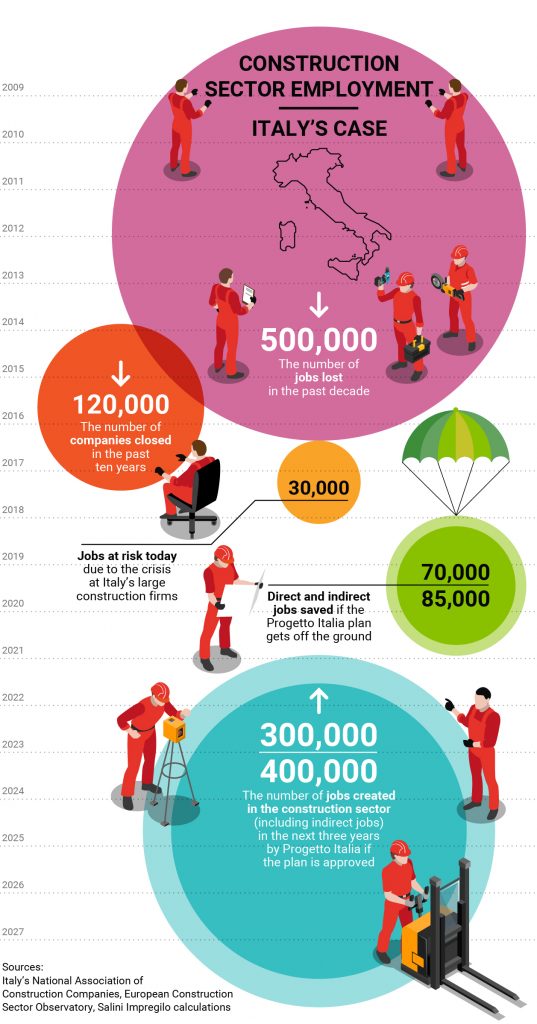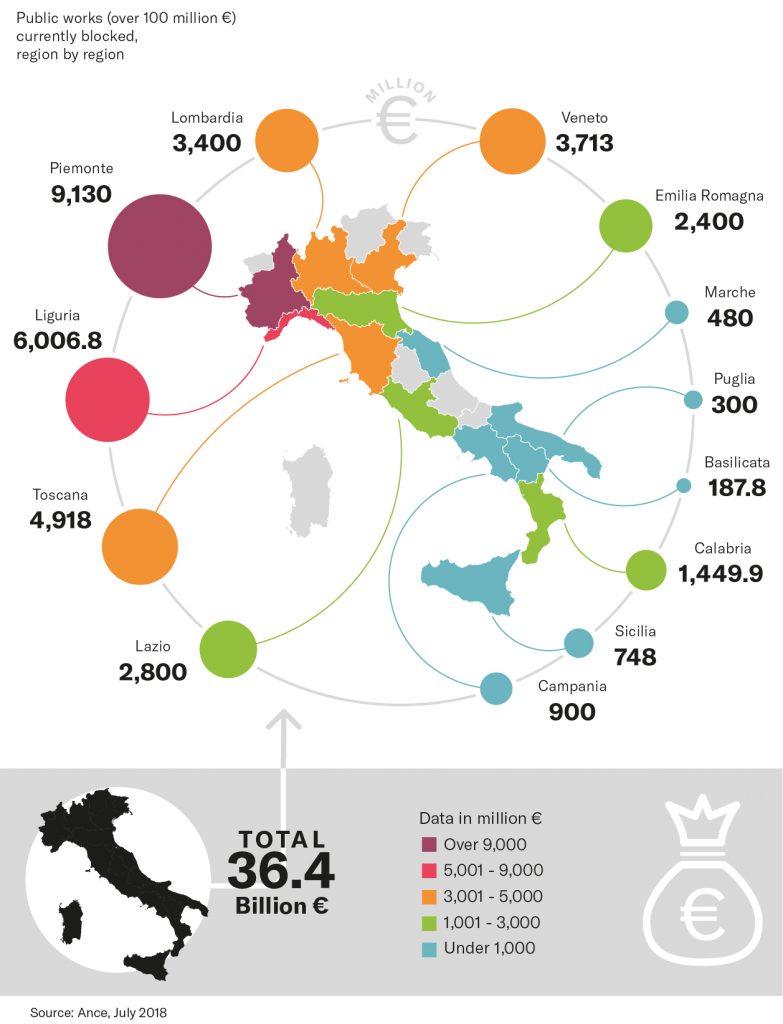The keyword is “beyond.” And it is used to describe an objective: to overcome a decade of stalled public works in Italy, rescue the best companies in the country, reopen the sites of strategic infrastructure projects and safeguard tens, if not hundreds, of thousands of jobs.
That is what lies behind Progetto Italia, or Project Italy: an industrial operation being proposed by Salini Impregilo, the sector leader in the country, to bring together some of the best companies and create a group that would have the scale and the resources to serve the domestic market as well as compete beyond it.
Progetto Italia
With the help of banks and institutions, the plan promises to add 0.2-0.3% to the country’s gross domestic product (GDP) every year by bringing together these companies, some healthier than others. The group that would be formed by this operation would be able to safeguard work for some 70,000 people, generate revenues of €14 billion and have an order book worth €61 billion. In addition to having a greater presence in the domestic market, it would be able to compete better against its larger rivals on the global market, deploying the expertise of small- and medium-sized companies for which Italy is known. More specifically, it would involve combining Salini Impregilo, Astaldi, the second biggest in the sector, and other companies.

A Bigger Group
The construction sector in Italy is worth €160 billion or 8% of the country’s GDP. It employs 1.4 million people and has a growth rate that could reach 3% by 2021, according to estimates by Cresme, a research outfit that specialises in the sector.
Despite this positive trend, many companies are in crisis. Five of the 10 biggest builders have begun proceedings to restructure their debt: Astaldi, Società Italiana Condotte d’Acqua, C.M.C., Grandi Lavori Fincosit and Trevi. This means that 30% of the sector’s revenues are frozen and some 30,000 people risk losing their jobs. It is a risk that comes after 500,000 jobs have already been lost in recent years.
Progetto Italia aims to reverse the situation. By rescuing the companies, these 30,000 jobs would be saved and expand to 400,000 during the next five years.
Unblocking construction sites

For years, Italy has had blocked construction sites, both big and small. The cause ranges from companies in financial difficulties to a lack of public funds to bureaucracy. The value of these blocked construction sites is equal to €36.4 billion, but it reaches €86 billion when considering the local economies around them, according to Associazione Nazionale Costruttori Edili (ANCE), the national builders’ union.
The total number of these sites blocked vary, depending on the source. Interior Minister Matteo Salvini speaks of nearly 300 sites. For Federazione Italiana Lavoratori Costruzioni e Affini (FILCA), the the construction workers’ union, it is 600. In terms of projects worth more than €100 million each, ANCE lists 25.
Blocked construction sites can be found in more than half of Italy’s regions, according to ANCE, from Piemonte with €9.1 billion worth of projects to Liguria with €6 billion. Tuscany has €4.9 billion worth of blocked sites, while Veneto has €3.7 billion.
The projects include a high-speed train line between Turin and Lyon, another one between Brescia and Verona. There is the Gronda highway in Genoa, as well as the highways between Roma and Latina, and Cremona and Mantova. There is also the Veneto ring road that would connect Verona with Vicenza and Padova.
It has come to the point that ANCE has launched an initiative called “Sbloccacantieri” that asks the public to identify blocked sites that might have been overlooked.
By rescuing companies in crisis, Progetto Italia would lead to the unblocking of construction sites in 14 regions worth a combined €30 billion.progetto-italia_02For years, Italy has had blocked construction sites, both big and small. The cause ranges from companies in financial difficulties to a lack of public funds to bureaucracy. The value of these blocked construction sites is equal to €36.4 billion, but it reaches €86 billion when considering the local economies around them, according to Associazione Nazionale Costruttori Edili (ANCE), the national builders’ union.
The total number of these sites blocked vary, depending on the source. Interior Minister Matteo Salvini speaks of nearly 300 sites. For Federazione Italiana Lavoratori Costruzioni e Affini (FILCA), the the construction workers’ union, it is 600. In terms of projects worth more than €100 million each, ANCE lists 25.
Blocked construction sites can be found in more than half of Italy’s regions, according to ANCE, from Piemonte with €9.1 billion worth of projects to Liguria with €6 billion. Tuscany has €4.9 billion worth of blocked sites, while Veneto has €3.7 billion.
The projects include a high-speed train line between Turin and Lyon, another one between Brescia and Verona. There is the Gronda highway in Genoa, as well as the highways between Roma and Latina, and Cremona and Mantova. There is also the Veneto ring road that would connect Verona with Vicenza and Padova.
It has come to the point that ANCE has launched an initiative called “Sbloccacantieri” that asks the public to identify blocked sites that might have been overlooked.
By rescuing companies in crisis, Progetto Italia would lead to the unblocking of construction sites in 14 regions worth a combined €30 billion.
Growth at home and abroad
Although the companies that would be involved in this consolidation are large, the impact of Progetto Italia would be felt all along the supply chain, which is composed of highly specialised small- and medium-sized businesses. This synergy would make the most of the sector’s strengths and create a solid group able to meet any client’s needs anywhere in the world.
In the last three years, Salini Impregilo and Astaldi have had about €4 billion worth of contracts with domestic suppliers, which is equal to 90% of business, generating an average of 20,000 jobs a year. This often leads to either company bringing suppliers overseas with them. Such was the case with the construction of the new Panama Canal where Salini Impregilo had Cimolai build the locks. It is a winning formula in an international market where projects require the highest technical expertise and greatest organizational skills.
Competing with big rivals
The group to be created by Progetto Italia would have the scale and resources to compete better against big rivals on the global market.
In their own respective home markets, these rivals reign supreme. About 60% of the top 250 groups in the world generate 75% of their revenues in their respective home markets. Such is the case for Vinci in France, ACS in Spain, Skanska in Sweden and Strabag in Austria.
By contrast, Salini Impregilo generates more than 90% of its revenues outside Italy. The sector is in this country is highly fragmented, where about 60% of some 500,000 businesses employ a single person. Just five of the businesses have revenues of more than €1 billion – and four of them are in crisis.
In a sign of a growing trend in Italy, more than 27% of projects in terms of value have gone to foreign builders in the last 15 years. And as local businesses keep disappearing, more opportunities are presenting themselves to foreign builders, which often favour bringing their own suppliers from abroad to work on projects to the detriment of local businesses. Foreign builders have also conducted their form of sector consolidation in Italy. Strabag acquired Adanti, while Sacyr works with Consorzio SIS along with others companies.
It is a significant risk for as sector that is considered strategic every else in the world, much like energy and telecommunications. Changing this trend would be the first challenge to be faced by the new group.

